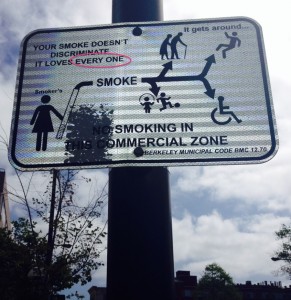Knowing the etymology and social history of words can be helpful in determining and remembering preferred forms. To that end, here is a very basic primer on some gender-related terminology:

Princess Kennedy as Mona. Photo and edit: Chad Kirkland. Illustration: Paul Frame. From slugmag.com.
Transgender: An adjective, as in transgender person. Not transgenders, as if a noun, nor transgendered, as if a verb—the -ed suffix comes with the implication that it is something that has happened or been done to someone, rather than a natural state, and is therefore not used. The difference is similar to that of person of color (n. + pp. acting as adj.) vs. colored (adj.)/coloreds (pl. n.), although those two terms have different meanings (people of color is inclusive of colored people, but not the reverse).
Cisgender: The opposite of transgender, cisgender people’s gender identities and the physical sexual characteristics they were born with are the same. The prefixes trans- and cis- are from Latin, and are used in the field of chemistry to describe molecular structure. The Latin trans means “across,” and cis means “on this side of”; as opposites they mean “on the same side” and “on the other side.” Cisgender woman or cis woman (a person who both identifies as, and was born with the sexual characteristics of, a female) is a term used in contrast to transgender woman or trans woman (a person who identifies as female but was born with the sexual characteristics of a male). In general usage (that is, when not specifically discussing gender issues), cis women and trans women are properly referred to as simply women. (Note that while transgender is spelled as one word, trans man and trans woman are not.)
Agender: Distinct from bigender or androgynous (meaning “both male and female”: bi- = “two”, andro- = “man”, -gynous = “having female parts”), agender (a- = “without”) is synonymous with genderless, or neutrois. Agender people sometimes use different pronouns, such as xe, thon, and hir, or may prefer the use of they as a singular pronoun. Some pronoun forms, such as he-she or shim, are usually considered derogatory and best avoided. The correct choice is always determined by the preference of the individual in question.
Trans*: The asterisk here is meant as a sort of wildcard, making trans* an umbrella term for the spectrum of non-conforming gender identities and expression: transgender, transsexual, agender, gender-fluid, non-binary, etc.—more colloquially, genderqueer people. Its popular use has been recently increasing in discourse on gender issues. It is basically an inclusive abbreviation.
Intersex: Mentioned here as it is important to not conflate the term intersex with those above. Intersex people have hormonal, genetic, or anatomical variations that cause physical sexual ambiguity. The term is biological rather than related to sexual orientation or gender expression, and is therefore not synonymous with transgender or pansexual.
Words to avoid:
Transsexual (or Transexual): A term used in the fields of medicine and psychology in the mid-twentieth century, before it was widely understood that sexual orientation and gender identity are distinct. it is not useful as an umbrella term synonymous with transgender—not all transgender people are transsexual. It also doesn’t fit well with our more clearly defined and understood common terminology for sexual orientation (heterosexual, homosexual, etc.). This ambiguity, along with the availability of more precise and correct terminology, makes transsexual largely obsolete.
Transvestite: the Latin vestire means “clothe,” so transvestite translates directly to “cross-dresser,” the preferred term. Transvestism can be a form of gender expression, but is not related to sexual orientation, and is not used to refer to transgender people—our traditional understanding of transvestite frequently, if not usually, has referred to cisgender, heterosexual men. The term cross-dresser means the same thing, but is clearer and not as easily confused with other sex- and gender-related terms.
Tranny, Trannie, Shemale, etc. We San Franciscans may have always thought of “tranny” as simply a word for a person who dresses in drag (as in the name of long-running local club Trannyshack), but “tranny” (and other words like it) are more often used as derogative terms for transgender people in the wider world. For this reason, the terms have fallen out of favor.
Cal’s Gender Equity Resource Center has a useful glossary of terms. Also see GLAAD’s Media Reference Guide.
Like this:
Like Loading...






